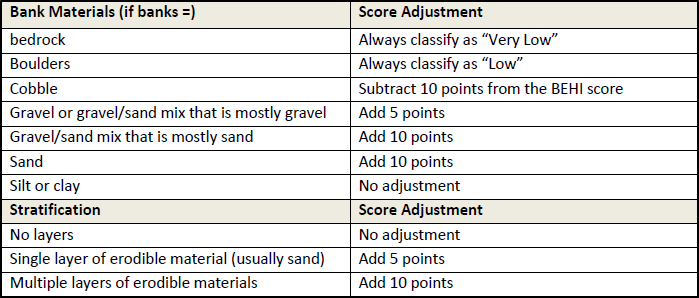The erosion of stream banks has been found to be a significant source of sediment to fluvial systems, especially in the presence of anthropogenic influences such as urbanization, agriculture, and dam construction. However, it is often difficult to distinguish between stream banks that are eroding at a natural rate and those that are eroding at unnaturally high rates as a result of altered hydrology or sediment loads.
The Bank Erosion Hazard Index (BEHI) is a tool originally developed by David Rosgen as a method of assessing the condition of channel banks, and their potential for erosion, as a way to inventory stream bank condition over large areas and prioritize efforts for remedial action. The system is based on assigning point values to stream segments, preferably 100 feet in length and/or 2-3 meander lengths, based upon a number of bank metrics including ratio of bank height to bankfull height, ratio of root depth to bank height, root density, surface protection, bank angle, bank materials, and stratification of bank material. The BEHI score is determined by summing the scores assigned to each of the first five metrics (top table) then adjusting the total score according to the presence and stratification of bank materials (bottom table) in order to determine an overall score that can be compared across systems.
Six of the seven metrics are observational while only one parameter requires quantitative measurement. Due to the difficulty of accurately measuring bankfull height, the BEHI method is often limited to professional assessments rather than volunteer groups. While the BEHI is not currently used in Indiana, a modified version that excludes the need for bankfull measurement has been used extensively in Michigan, and a similar program is currently under development by the Indiana Fluvial Erosion Hazard Mitigation Program.

Rosgen, D.L. 2001. A Practical Method of Computing Streambank Erosion Rate. Proceedings of the Seventh Federal Interagency Sedimentation Conference, Vol. 2, pp. II – 9-15, March 25-29, 2001, Reno, NV. Online at: http://www.wildlandhydrology.com/assets/Streambank_erosion_paper.pdf
Rosgen, D.L. 2008. River Stability Field Guide. Wildland Hydrology, Fort Collins, CO.
*Frankenberger, J., and Esman, L. 2012. Monitoring Water in Indiana: Choices for Nonpoint Source and Other Watershed Projects. Department of Agriculture and Biological Engineering, Purdue University, Indiana. 140p. Online at https://engineering.purdue.edu/watersheds/monitoring/MonitoringWaterinIndiana.2012.1.pdf
*Note: All information and images included in this section are courtesy of Frankenberger and Esman, 2012. For more information, visit the link provided above.
